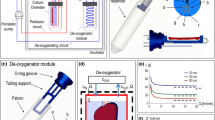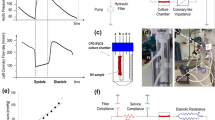Abstract
Bovine saphenous veins (BSV) were incubated in a perfusion bioreactor to study vessel wall metabolism and wall structure under tissue engineering conditions. Group 1 vessels were perfused for 4 or 8 days. The viscosity of the medium was increased to that of blood in group 2. Group 3 vessels were additionally strained with luminal pressure. Groups 1-d through 3-d were similar except that BSV were endothelium-denuded before perfusion. Groups 1-a through 3-a used native vessels at elevated flow rates. Group 3 vessels responded significantly better to noradrenaline on day 4, whereas denuded vessels showed attenuated responses (p < 0.001). Tetrazolium dye reduction did not depend on perfusion conditions or time except for denuded vessels. pO2 gradients across the vessels were independent of time and significantly higher in group 2 (p < 0.001). BSV converted glucose stoichiometrically to lactate except vessels of groups 3, 1-d, and 3-d which released more lactate than glucose could supply (p < 0.001). Group 1 vessels as well as all vessels perfused with elevated flow rates showed a loss of endothelial cells after 4 days, whereas group 2 and 3 vessels retained most of the endothelium. These data suggest that vessel metabolism was not limited by oxygen supply. Shear forces did not affect glucose metabolism but increased oxygen consumption and endothelial cell survival. Luminal pressure caused the utilization of energy sources other than glucose, as long as the endothelium was intact. Therefore, vessel metabolism needs to be monitored during tissue engineering procedures which challenge the constructs with mechanical stimuli.












Similar content being viewed by others
References
Aoki, J., A. T. L. Ong, C. A. Arampatzis, M. Vijaykumar, G. A. Rodriguez Granillo, C. M. C. Disco, and P. W. Serruys. Comparison of three-year outcomes after coronary stenting versus coronary artery bypass grafting in patients with multivessel coronary disease, including involvement of the left anterior descending coronary artery proximally (a subanalysis of the arterial revascularization therapies study trial). Am. J. Cardiol. 94:627–631, 2004.
Berridge, M. V., P. M. Herst, and A. S. Tan. Tetrazolium dyes as tools in cell biology: new insights into their cellular reduction. Biotechnol. Annu. Rev. 11:127–152, 2005.
Busse, R., and I. Fleming. Regulation of endothelium-derived vasoactive autacoid production by hemodynamic forces. Trends Pharmacol. Sci. 24:24–29, 2003.
Chace, K. V., and R. Odessey. The utilization by rabbit aorta of carbohydrates, fatty acids, ketone bodies, and amino acids as substrates for energy production. Circ. Res. 48:850–858, 1981.
Clerin, V., R. J. Gusic, J. O’Brien, P. M. Kirshbom, R. J. Myung, J. W. Gaynor, and K. J. Gooch. Mechanical environment, donor age, and presence of endothelium interact to modulate porcine artery viability ex vivo. Ann. Biomed. Eng. 30:1117–1127, 2002.
Denis, C. V. Molecular and cellular biology of von Willebrand factor. Int. J. Hematol. 75:3–8, 2002.
Engbers-Buijtenhuijs, P., L. Buttafoco, A. A. Poot, P. J. Dijkstra, R. A. I. De Vos, L. M. T. Sterk, R. H. Geelkerken, I. Vermes, and J. Feijen. Biological characterisation of vascular grafts cultured in a bioreactor. Biomaterials 27:2390–2397, 2006.
Gaucher, C., C. Devaux, C. Boura, P. Lacolley, J. Stoltz, and P. Menu. In vitro impact of physiological shear stress on endothelial cells gene expression profile. Clin. Hemorheol. Microcirc. 37:99–107, 2007.
Glacken, M. W., R. J. Fleischaker, and A. J. Sinskey. Reduction of waste product excretion via nutrient control: possible strategies for maximizing product and cell yields on serum in cultures of mammalian cells. Biotechnol. Bioeng. 28:1376–1389, 1986.
Gruberg, L., S. Milo, M. Ben Tzvi, C. Lotan, G. Merin, S. Braun, R. Mohr, D. Tzivoni, D. Bitran, and R. Beyar. Comparison of bypass surgery and stenting for the treatment of multivessel disease: results from the ARTS trial in Israel. Isr. Med. Assoc. J. 5:539–542, 2003.
Gusic, R. J., R. Myung, M. Petko, J. W. Gaynor, and K. J. Gooch. Shear stress and pressure modulate saphenous vein remodeling ex vivo. J. Biomech. 38:1760–1769, 2005.
Hannan, E. L., M. J. Racz, G. Walford, R. H. Jones, T. J. Ryan, E. Bennett, A. T. Culliford, O. W. Isom, J. P. Gold, and E. A. Rose. Long-term outcomes of coronary-artery bypass grafting versus stent implantation. N. Engl. J. Med. 352:2174–2183, 2005.
He, G. W. Arterial grafts for coronary artery bypass grafting: biological characteristics, functional classification, and clinical choice. Ann. Thorac. Surg. 67:277–284, 1999.
Hellstrand, P., B. Johansson, and K. Norberg. Mechanical, electrical, and biochemical effects of hypoxia and substrate removal on spontaneously active vascular smooth muscle. Acta Physiol. Scand. 100:69–83, 1977.
Hoenicka, M., K. Lehle, V. R. Jacobs, F. X. Schmid, and D. E. Birnbaum. Properties of the human umbilical vein as a living scaffold for a tissue-engineered vessel graft. Tissue Eng. 13:219–229, 2007.
Hoenig, M. R., G. R. Campbell, and J. H. Campbell. Vascular grafts and the endothelium. Endothelium 13:385–401, 2006.
Lawrence, A. R., and K. J. Gooch. Transmural pressure and axial loading interactively regulate arterial remodeling ex vivo. Am. J. Physiol. Heart Circ. Physiol. 297:H475–H484, 2009.
Lindqvist, A., K. Dreja, K. Swärd, and P. Hellstrand. Effects of oxygen tension on energetics of cultured vascular smooth muscle. Am. J. Physiol. Heart Circ. Physiol. 283:H110–H117, 2002.
Malda, J., T. J. Klein, and Z. Upton. The roles of hypoxia in the in vitro engineering of tissues. Tissue Eng. 13:2153–2162, 2007.
Mamode, N., and R.N. Scott. Graft type for femoro-popliteal bypass surgery. Cochrane Database Syst. Rev. CD001487, 1999.
Marshall, N. J., C. J. Goodwin, and S. J. Holt. A critical assessment of the use of microculture tetrazolium assays to measure cell growth and function. Growth Regul. 5:69–84, 1995.
Mazzucotelli, J. P., L. Lecouls, A. Hamzaoui, C. Philippon, E. Bizouard, M. Moczar, and D. Y. Loisance. The superiority of hollow fiber membrane over bubble oxygenator in a perfusion circuit for the evaluation of small caliber endothelialized arterial prostheses. Artif. Organs 20:30–36, 1996.
McAllister, T. N., M. Maruszewski, S. A. Garrido, W. Wystrychowski, N. Dusserre, A. Marini, K. Zagalski, A. Fiorillo, H. Avila, X. Manglano, J. Antonelli, A. Kocher, M. Zembala, L. Cierpka, L. M. de la Fuente, and N. L’Heureux. Effectiveness of haemodialysis access with an autologous tissue-engineered vascular graft: a multicentre cohort study. Lancet 373:1440–1446, 2009.
Morrison, E. S., R. F. Scott, M. Kroms, and J. Frick. Glucose degradation in normal and atherosclerotic aortic intima-media. Atherosclerosis 16:175–184, 1972.
Nichol, J. W., M. Petko, R. J. Myung, J. W. Gaynor, and K. J. Gooch. Hemodynamic conditions alter axial and circumferential remodeling of arteries engineered ex vivo. Ann. Biomed. Eng. 33:721–732, 2005.
Obradovic, B., R. L. Carrier, G. Vunjak-Novakovic, and L. E. Freed. Gas exchange is essential for bioreactor cultivation of tissue engineered cartilage. Biotechnol. Bioeng. 63:197–205, 1999.
Paszkowiak, J. J., and A. Dardik. Arterial wall shear stress: observations from the bench to the bedside. Vasc. Endovascular Surg. 37:47–57, 2003.
Paul R. J. Chemical energetics of vascular smooth muscle. In: Vascular Smooth Muscle, edited by D. F. Bohr, A. P. Somlyo, and H. V. J. Sparks. Bethesda, MD: American Physiology Society, 1980, pp. 201–235.
Perkins, J. P. Catecholamine-induced modification of the functional state of [beta]-adrenergic receptors. TIPS 2:326–328, 1981.
Rashid, S. T., H. J. Salacinski, B. J. Fuller, G. Hamilton, and A. M. Seifalian. Engineering of bypass conduits to improve patency. Cell Prolif. 37:351–366, 2004.
Waybill, P. N., and L. J. Hopkins. Arterial and venous smooth muscle cell proliferation in response to co-culture with arterial and venous endothelial cells. J. Vasc. Interv. Radiol. 10:1051–1057, 1999.
Wayman, B. H., W. R. Taylor, A. Rachev, and R. P. Vito. Arteries respond to independent control of circumferential and shear stress in organ culture. Ann. Biomed. Eng. 36:673–684, 2008.
Wechezak, A. R., D. E. Coan, R. F. Viggers, and L. R. Sauvage. Dextran increases survival of subconfluent endothelial cells exposed to shear stress. Am. J. Physiol. 264:H520–H525, 1993.
Wong, A. P., N. Nili, and B. H. Strauss. In vitro differences between venous and arterial-derived smooth muscle cells: potential modulatory role of decorin. Cardiovasc. Res. 65:702–710, 2005.
Yow, K., J. Ingram, S. A. Korossis, E. Ingham, and S. Homer-Vanniasinkam. Tissue engineering of vascular conduits. Br. J. Surg. 93:652–661, 2006.
Zhang, W. J., W. Liu, L. Cui, and Y. Cao. Tissue engineering of blood vessel. J. Cell. Mol. Med. 11:945–957, 2007.
Zhang, X., X. Wang, V. Keshav, X. Wang, J. T. Johanas, G. G. Leisk, and D. L. Kaplan. Dynamic culture conditions to generate silk-based tissue-engineered vascular grafts. Biomaterials 30:3213–3223, 2009.
Acknowledgments
This work was supported by grants from Deutsche Forschungsgemeinschaft (BI 139/2-1, HA 4380/5-1, and LI 256/68-1). The authors wish to thank Prof. D. Liepsch, University of Applied Sciences Munich, for medium viscosity measurements and A. Klose, University of Regensburg Medical Center, for helpful discussions about vessel handling and surgical procedures.
Author information
Authors and Affiliations
Corresponding author
Additional information
Associate Editor Peter E. McHugh oversaw the review of this article.
Rights and permissions
About this article
Cite this article
Hoenicka, M., Wiedemann, L., Puehler, T. et al. Effects of Shear Forces and Pressure on Blood Vessel Function and Metabolism in a Perfusion Bioreactor. Ann Biomed Eng 38, 3706–3723 (2010). https://doi.org/10.1007/s10439-010-0116-1
Received:
Accepted:
Published:
Issue Date:
DOI: https://doi.org/10.1007/s10439-010-0116-1




